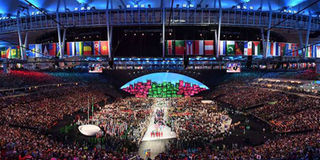The Maracana Stadium: A tale of stark contradiction

Delegations parade during the opening ceremony of the Rio 2016 Olympic Games at the Maracana Stadium in Rio de Janeiro on August 5, 2016. PHOTO | GABRIEL BOUYS |
What you need to know:
- Needing just a draw to win the Cup in the round-robin tournament, the over-confident hosts nevertheless succumbed to a 2-1 loss to Uruguay and the term “Maracanazo”
- The official number of spectators for that game was 199,854.
- Maracana was the venue for the opening and will be the venue for the closing ceremonies of the Rio 2016 Olympics.
As a football fan, I grew up with the legend of the Maracana Stadium.
It was the biggest stadium in the world. It could sit 200,000 people. Think about that! Brazil built it for the 1950 World Cup, which it hosted but never factored a loss, even though it was a game of football being played.
Needing just a draw to win the Cup in the round-robin tournament, the over-confident hosts nevertheless succumbed to a 2-1 loss to Uruguay and the term “Maracanazo” – “The Maracana Blow” – entered Brazilian lexicon. Even after the catastrophic 7-1 semi-final loss to Germany in 2014, 1950 has endured as a national disaster in Brazil.
The official number of spectators for that game was 199,854. Maracana was the venue for the opening and will be the venue for the closing ceremonies of the Rio 2016 Olympics. I am happy to be in Brazil to pay homage to this iconic ground. I have associated Maracana with some of the football stars who made me enjoy dreaming:
Pele, Garrincha, Tostao, Rivelino, Gerson, Carlos Alberto, Jairzinho, Toninho Cerezo, Junior, Falcao, Zico, Socrates, Eder, Careca, Paolo Cesar, Ronaldo, Ronaldinho, Rivaldo, Romario and now, Neymar.
I wanted to see Pele during the opening ceremonies. The plan was that he would be the one to light the Olympic flame. But he is unwell and could not make it.
I have been passing by the Maracana almost every day. By the time I leave, I expect to have been inside it three times – more than I could ask for. Yet the reverence with which the football world holds Maracana is but one side of the story. There is another side, a darker one. The venues of the 2016 Olympics, like those of the 2014 World Cup before them, have been constructed by well-heeled cartels. For reasons best known to these cartels, Maracana has undergone continuous renovation for the last 15 years. These works have consumed about Sh52.8 billion of tax payers money.
Maracana’s current sitting capacity is now 79,000.
Maracana, which is actually a sports complex like Safaricom Kasarani, is run by a private consortium that won a concession from the state government to do so. One of the companies in this consortium, IMX was also responsible for the feasibility study of the concession that it won.
Justica Global, a Brazilian human rights non-governmental organisation, said in a report on the shenanigans surrounding Maracana: “After the renovation and privatisation of the stadium in 2013, tickets for the games there skyrocketed from an average R$ 14 (about sh462) to R$45 (about Sh1,485).”
After making a killing renovating the stadium for doubtful purposes and fleecing the public with expensive tickets, the consortium now wants to return Maracana to state control because business has slumped. The state government doesn’t want it.
A solution being mulled is to turn over control of Maracana to a Rio football club.
Flamengo has expressed interest in the idea but nothing concrete has been reached.
For now, the focus is on the Olympics. After that, hard decisions will have to be made. However they go, the buccaneers have already made their money.





